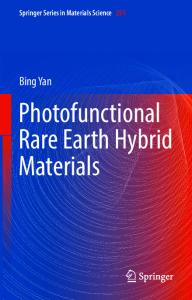Thermal Analysis of Rare Earth Additions to HY100
- PDF / 820,350 Bytes
- 9 Pages / 593.972 x 792 pts Page_size
- 60 Downloads / 331 Views
JMEPEG (2019) 28:2707–2715 https://doi.org/10.1007/s11665-019-04022-1
Thermal Analysis of Rare Earth Additions to HY100 R.B. Tuttle (Submitted December 4, 2018; in revised form February 13, 2019; published online May 3, 2019) This paper discusses the results of a series of experiments on rare earth additions to HY100. Previous work has found little or no refinement to occur with rare earth additions to this alloy. Thermal analysis has been used to provide a better understanding of this and assist in the development of a suitable grain refiner. Heats of HY100 were melted in an induction furnace and tapped into a small hand ladle. Thermal analysis cups were poured from the ladle, and the resulting cooling data recorded. Heats with no additions and 0.3 wt.% rare earth silicide were poured. Commercial software analyzed the cooling curves to determine the liquidus and solidus temperatures. A manual analysis was employed for identifying the peritectic and other reactions. Examination of the cooling curves detected the liquidus, solidus and even peritectic reactions. It was observed that the solidification changed with the rare earth silicide or engineered grain refiner additions. Additional phase reactions appeared before the solidus were not present in the baseline heat. Phase identification was done with thermodynamic calculations. The solidus, peritectic and liquidus were found. Rare earth inclusions were observed in the microstructure of the treated steel. Interestingly, macrostructure examination indicated no reduction in overall grain size. Thermodynamic predictions also indicated that the inclusions formed late during solidification. It was postulated that the additions caused a change in solidification but those occurred late enough during freezing that the resulting microstructure was not affected. Keywords
heterogeneous nucleation, metalcasting, rare earth, steel, thermal analysis
1. Introduction HY100 steels were originally developed to meet demanding requirements for naval structures. The main features of the alloy are its high strength and toughness. These are achieved via a quench and tempered (Q&T) microstructure. HY100 has also become used in boiler applications. Like most steels, continued development is critical for advancing end-use markets and expanding the applications where an alloy can be employed. Steel castings from HY100 provide similar properties to their wrought counterparts, but the solidification structure can limit mechanical properties (Ref 1). Improving HY100 castings would allow the broader use of this alloy in foundry applications. One limitation of the steel casting route is that thermomechanical approaches to refining the microstructure are not applicable (Ref 2, 3). Thus, a different approach is required. Reducing the grain size in metals has long been known to improve properties (Ref 4-6). For the foundry process, reducing grain size involves two routes: increasing the cooling rate or manipulating the melt. Increasing the cooling rate often requires a change in the mold material to a metal
Data Loading...











